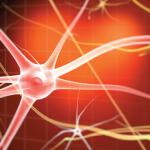 ORLANDO—Chronic pain affects many people with rheumatic disease, and its management often falls on rheumatology providers. We want to help our patients feel better but may struggle to do so when standard immunomodulatory therapies fail to provide relief. At the 2022 ACR Education Exchange, April 28–May 1, Delia Chiaramonte, MD, chief, Division of Integrative Palliative Medicine, Greater Baltimore Medical Center, gave a presentation on how we can better help our patients cope with chronic pain, augment physical function and improve quality of life.
ORLANDO—Chronic pain affects many people with rheumatic disease, and its management often falls on rheumatology providers. We want to help our patients feel better but may struggle to do so when standard immunomodulatory therapies fail to provide relief. At the 2022 ACR Education Exchange, April 28–May 1, Delia Chiaramonte, MD, chief, Division of Integrative Palliative Medicine, Greater Baltimore Medical Center, gave a presentation on how we can better help our patients cope with chronic pain, augment physical function and improve quality of life.
More Than Nociception
Dr. Chiaramonte began with an important point: Pain is more than nociception. Nociception is the process by which painful stimuli are communicated through the peripheral and central nervous system (CNS). Pain is affected by emotions, genetics and the context of a person’s life (e.g., social connections, current circumstances).
“Pain isn’t always about tissue damage,” she said. “There’s a part that’s brain based, and what the brain decides in terms of threat can either increase or decrease pain. So a big part of chronic pain management is educating our patients about the top-down [effect] of the brain on pain.”
An increased perception of threat increases pain. Put simply, the brain receives a sensation and then decides if it hurts. Example: Anxiety is a generalized sense of threat (i.e., everything is bad and scary) and increases pain. Providers may inadvertently increase perception of threat through word choice.
“When we say things like: ‘This is the worst MRI I’ve ever seen’ or ‘You’re bone on bone,’ patients are understandably alarmed. Perceived threat increases and, in turn, so does pain. We need to be thoughtful about our word choices. Decreasing the sense of threat is part of managing a patient’s pain,” Dr. Chiaramonte said.
Catastrophizing—or viewing a situation as considerably worse than it actually is—also worsens pain by increasing the perception of threat. In a study of 38 healthy people in which topical capsaicin was applied to the dorsum of the hand, subjects who showed the largest initial increases in catastrophizing reported the greatest subsequent increases in pain.
“This study was so interesting because it showed that the catastrophizing actually comes first. So managing catastrophizing is key,” she said.1
Central sensitization—the amplification of neural signaling within the CNS that elicits pain hypersensitivity—also plays a role in chronic pain. When central sensitization is present, the CNS may distort neutral stimuli, such as touch and movement.
“If the brain thinks something is wrong, it turns up sensitivity to protect us from missing something,” Dr. Chiaramonte said. “I give my patients the example of a smoke alarm that’s dysfunctional. If your smoke alarm goes off every time you cook, that’s not helpful. It’s also not helpful if it never goes off. [The alarm] has to be tuned properly so it allows you to cook but alerts you to a fire if one is present.”
In summary, central sensitization plus negative cognitions (e.g., catastrophizing, fear of pain and hypervigilance) lead to pain amplification and increasing disability. Dr. Chiaramonte concluded, “This is the key thing we need to teach our patients about: the role the brain plays in increasing or decreasing pain.”
Pain is more than nociception, the process by which painful stimuli are communicated through the peripheral and central nervous system. Pain is affected by emotions, genetics & the context of a person’s life.
Tools for Managing Pain
Dr. Chiaramonte discussed a multifaceted approach to pain management. “Pain management is more than just medications,” she said. “If you just stick with meds, most of these people won’t get better. Procedures, topicals, mind-body techniques, manual therapies, acupuncture, counseling and behavioral interventions are in your toolbox, too.”
Mind-body techniques, such as meditation, guided imagery, biofeedback, yoga and tai chi can play a role in chronic pain management. “These [options] are super cheap and super safe, so they’re definitely worth exploring,” Dr. Chiaramonte said. “The best option is the one the patient will actually do.”
Example: Both guided imagery and tai chi have been shown to improve fibromyalgia symptoms.2,3 Tai chi has also been shown to improve pain and physical function in those with knee, hip and hand osteoarthritis, as well as rheumatoid arthritis.4
For the patient who is extremely motivated, mindfulness-based stress reduction can be particularly helpful. Mindfulness-based stress reduction is a standardized program developed to reduce suffering for people with chronic pain. It’s an eight-week group experience that involves a seven-hour retreat, 2.5-hour sessions weekly and home practice for 45 minutes daily. The program costs vary.5
“There’s lots of evidence for benefit of [mindfulness-based stress reduction] in pain, anxiety, depression, sleep, health-related quality of life and perceived stress,” Dr. Chiaramonte said. “It was even shown to help adults with chronic low back pain.”5
When it comes to medications, Dr. Chiaramonte highlighted the potential value of intravenous ketamine for patients for whom common therapies, such as antidepressants, antiepileptics and opiates, proved ineffective. Consensus guidelines on the use of intravenous ketamine for chronic pain cite evidence in support of its use, but higher quality, larger, controlled trials are needed.6
Dr. Chiaramonte concluded with an important message: “The goal of pain management isn’t the pain number. It’s function and quality of life. Did you start playing tennis again? Can you walk the dog or clean the house? This is the stuff that matters,” she said.
Summary
Pain is more than just nociception, and pain management is more than just medication. We can help our patients cope with chronic pain by using multifaceted management strategies. Education about the relationship between perceived threat and pain, as well as central sensitization, is key. In essence, “hurt doesn’t always mean harm.”
Samantha C. Shapiro, MD, is an academic rheumatologist and an affiliate faculty member of the Dell Medical School at the University of Texas at Austin. She received her training in internal medicine and rheumatology at Johns Hopkins University, Baltimore. She is also a member of the ACR Insurance Subcommittee.
References
- Campbell CM, Quartana PJ, Buenaver LF, et al. Changes in situation-specific pain catastrophizing precede changes in pain report during capsaicin pain: A cross-lagged panel analysis among healthy, pain-free participants. J Pain. 2010 Sep;11(9):876–884.
- Cheng CA, Chiu YW, Wu D, et al. Effectiveness of Tai Chi on fibromyalgia patients: A meta-analysis of randomized controlled trials. Complement Ther Med. 2019 Oct;46:1–8.
- Menzies V, Taylor AG, Bourguignon C. Effects of guided imagery on outcomes of pain, functional status, and self-efficacy in persons diagnosed with fibromyalgia. J Altern Complement Med. Jan–Feb 2006;12(1):23–30.
- Uhlig T. Tai Chi and yoga as complementary therapies in rheumatologic conditions. Best Pract Res Clin Rheumatol. 2012 Jun;26(3):387–398.
- Cherkin DC, Sherman KJ, Balderson BH, et al. Effect of mindfulness-based stress reduction vs cognitive behavioral therapy or usual care on back pain and functional limitations in adults with chronic low back pain: A randomized clinical trial. JAMA. 2016 Mar 22–29;315(12):1240–1249.
- Cohen SP, Bhatia A, Buvanendran A, et al. Consensus Guidelines on the Use of Intravenous Ketamine Infusions for Chronic Pain from the American Society of Regional Anesthesia and Pain Medicine, the American Academy of Pain Medicine, and the American Society of Anesthesiologists. Reg Anesth Pain Med. 2018 Jul;43(5):521–546.


